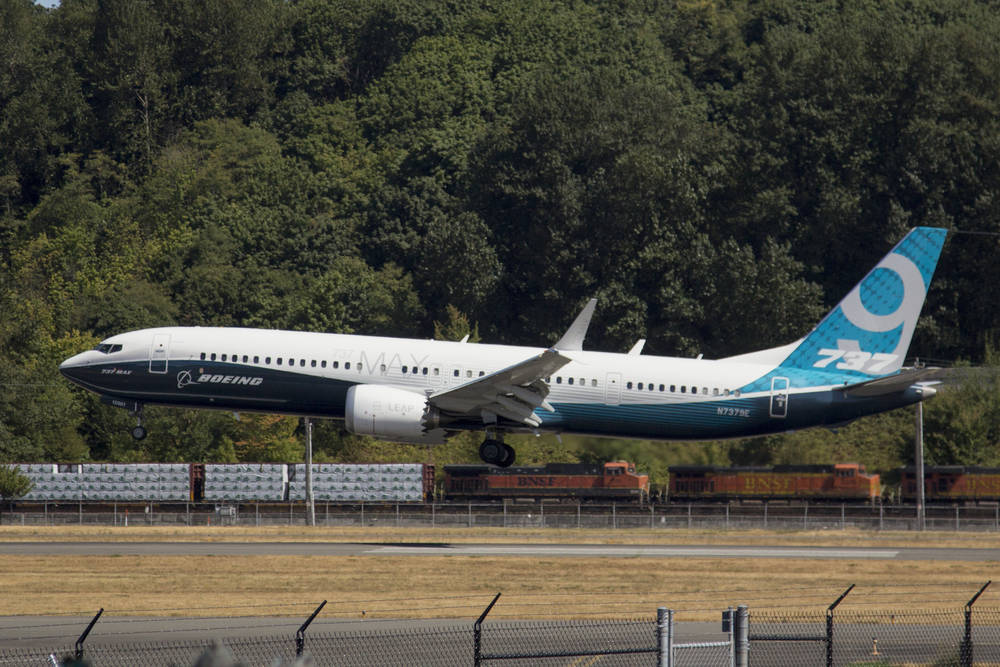Alaska Airlines' Door-dropping Flight Was Missing Bolts

The door plug that fell out of Alaska Airlines flight 1282 last month wasn’t properly bolted into place, according to a preliminary investigation.
Seven passengers and one flight attendant suffered minor injuries during the January 5 incident, when a Boeing 737-9 Max bound for Ontario, California, experienced a rapid decompression when the door plug - a structure installed in place of an optional emergency door – fell out. The bolts connecting the Mid Exit Door plug (MED plug) to the airframe were missing, it has subsequently been shown.
All 177 passengers and crew on board de-planed safely.
Boeing's reputation, however, took a battering as it represented yet another example of the aerospace giant getting it wrong on safety and quality control.
However the preliminary investigation report issued on Tuesday by the US National Transportation Safety Board (NTSB), stops short of assigning blame for the incident.
The document observes that cabin pressure control system functioned as designed, and that airplane maintenance logs showed entries "indicating that a pressure controller light had illuminated on three previous flights."
So that part of the plane performed as intended, at least.
The report also considers the state of the blown-out door plug, which was recovered in the backyard of a private residence and analyzed at the NTSB's Maintenance Laboratory. That examination found the door "departed the airplane" due to four bolts designed to hold it in place not being present.
"Overall, the observed damage patterns and absence of contact damage or deformation around holes associated with the vertical movement arrestor bolts and upper guide track bolts in the upper guide fittings, hinge fittings, and recovered aft lower hinge guide fitting indicate that the four bolts that prevent upward movement of the MED plug were missing before the MED plug moved upward off the stop pads," the report states.
It appears the bolts went missing before the flight took off. The report indicates they were removed after the creation of a work order to fix five damaged rivets at the edge of the door frame. The rivet repair was performed by employees of contractor Spirit AeroSystems, the MED plug maker, on September 19 last year. According to a photo exchanged by Boeing team members who were discussing interior renovation that would follow the rivet fix, there were no bolts visible in three locations at that point.
- Boeing goes boing: 757 loses a wheel while taxiing down the runway
- United Airlines' patience with Boeing is maxed out after repeated safety issues
- Travel app Kayak offers Boeing 737 Max 9 filter after that door plug drama
- Perfect timing... US Navy throws Boeing $103M to update its sub recon jets
The report also noted that the Cockpit Voice Recorder (CVR) on the Boeing 737-9 MAX didn’t retain recordings of pilot chatter during the incident, because it’s only required to store two hours of audio before overwriting itself. It’s possible to override that limit, but nobody appears to have bothered.
"The CVR circuit breaker had not been manually deactivated after the airplane landed following the accident in time to preserve the accident flight recording," the report reveals, noting that the Flight Data Recorder did document the period when the door plug "departed."
The NTSB’s report doesn’t mention data recovery efforts to retrieve the overwritten audio, which IRTR finds odd as the org knows that modern CVRs use digital storage media. Our experience with data recovery services suggests it’s possible to recover info that’s been overwritten, even on reformatted drives.
The NTSB is continuing to look into Boeing's manufacturing process and associated records.
On January 25 Boeing issued a message to aircraft operators with revised guidance for inspecting 737-9 MAX aircraft with MED plugs. Earlier this week, Boeing announced that it expects to have to delay aircraft delivery to customers in order to rework about 50 aircraft fuselages due to poorly drilled rivet holes.
In a statement issued in conjunction with the NTSB report, Boeing president and CEO Dave Calhoun conceded, "Whatever final conclusions are reached, Boeing is accountable for what happened. An event like this must not happen on an airplane that leaves our factory. We simply must do better for our customers and their passengers. We are implementing a comprehensive plan to strengthen quality and the confidence of our stakeholders. It will take significant, demonstrated action and transparency at every turn – and that is where we are squarely focused."
A month after the incident, Boeing's stock is down about 18 percent. ®
From Chip War To Cloud War: The Next Frontier In Global Tech Competition
The global chip war, characterized by intense competition among nations and corporations for supremacy in semiconductor ... Read more
The High Stakes Of Tech Regulation: Security Risks And Market Dynamics
The influence of tech giants in the global economy continues to grow, raising crucial questions about how to balance sec... Read more
The Tyranny Of Instagram Interiors: Why It's Time To Break Free From Algorithm-Driven Aesthetics
Instagram has become a dominant force in shaping interior design trends, offering a seemingly endless stream of inspirat... Read more
The Data Crunch In AI: Strategies For Sustainability
Exploring solutions to the imminent exhaustion of internet data for AI training.As the artificial intelligence (AI) indu... Read more
Google Abandons Four-Year Effort To Remove Cookies From Chrome Browser
After four years of dedicated effort, Google has decided to abandon its plan to remove third-party cookies from its Chro... Read more
LinkedIn Embraces AI And Gamification To Drive User Engagement And Revenue
In an effort to tackle slowing revenue growth and enhance user engagement, LinkedIn is turning to artificial intelligenc... Read more

